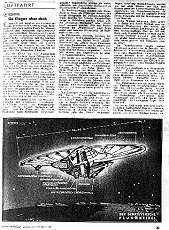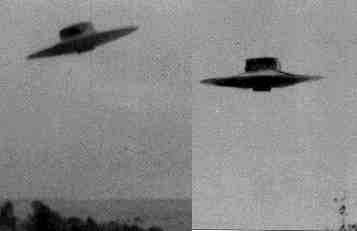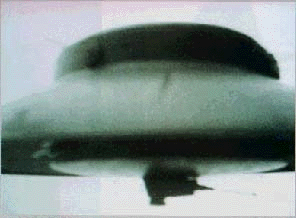Photos above and below of alleged Nazi
flying saucers. Both
are considered hoaxes.
Schreiver Flying Disc




The concept of "flying saucers" has become synonymous with that of UFO, and by logical extension, to "extraterrestrial spacecraft." The truth is that these concepts are not necessarily related.
Long before Kenneth Arnold initiated the modern age of the societal phenomenon known as UFO, there were already "flying saucers" that had little in common with spacecraft from other planets.
Any enthusiast of aviation history will have encountered sketches of "flying saucers" and discoidal aircraft more than once in aviation catalogues and publications. In his own day, Leonardo Da Vinci had already sketched the outlines of circular vehicles: war wagons, movable fortresses, and other artifacts which, had they been endowed with the power of flight, would be the perfect ancestors of our "flying saucers."
During the 1930's, a number of circular wing aircraft were built in the United States, some of which would eventually confuse ufologists, who took them as evidence of UFOs which had crashed on American soil. On one hand, H. Zimmerman conducted several tests in 1932 with a variety of circular wing aircraft inside a wind tunnel in order to prove the lesser degree of distension in their extremities. The results of these tests were published in
"Technical Report 431," issued by NACA (known today as NASA), producing a genuine sensation and leading to the creation of US patent 2,108,093. A practical use for them would be found later on in the "Chance Vought 173" whose maiden flight occurred in 1942.
In its February 1989 issue, the German magazine Flugzeug published the following report made by a German aviation official who, allegedly, been the protagonist of the astonishing sighting involving a "flying saucer" at the Prag-Gbell (formerly Praha-Kbely) aerodrome in 1943. The controversial report follows:
"Place of Sighting: C 14 Flight School at the Prag-Gbell aerodrome. Date of Event: August/September 1943, supposedly on a Sunday (I seem to recall there were no services on that day. The weather was good, dry and sunny. Kind of Observation: "I was with my flight comrades on the air strip, more precisely, near the school buildings, some 2000 meters away from the arsenal (located to the extreme left). See adjoining diagram.
The device was inside the hangar: a disk some 5-6 meters in diameter. Its body is relatively large at the center. Underneath, it has four tall, thin legs. Color: Aluminum. Height: Almost as tall as a man. Thickness: some 30 - 40 cm., with an rim of external rods, perhaps square orifices.
The upper part of the body (almost a third of the total height) was shrunken over the upper half of the disk. It was flat and rounded. See the attached sketch for the lower
half.
Along with my friends, I saw the device emerge from the hangar. It was then that we heard the roar of the engines, we saw the external side of the disk begin to rotate, and the vehicle began moving slowly and in a straight line toward the southern end of the field. It then rose almost 1 meter into the air. After moving around some 300 meters at
that altitude, it stopped again. Its landing was rather rough.
We had to leave the area while some custodians pushed the vehicles toward the hangar. Later on, the "thing" took off again, managing to reach the end of the aerodrome this
time.
Afterwards, I made a note in my flight log of the members
of the FFS C14 who were present at the moment: Gruppenfluglehrer (group flight instructor) Ofw. Michelsen; Fluglehrer Uffz. Kolh und Buhler; Flugschüler (flight students): Ogefr, Klassmann, Kleiner, Müller, Pfaffle, Schenk, Seifert, Seibert, Squarr, Stahn, Weinberger, Zoebele, Gefr, Hering, Koza, Sitzwohl, Voss, and Waluda."
Certainly, even Flugzeug's editors treat the report cautiously: "the device described by these observers is antithetical to those described by Schreiver, Habermohl, Miethe, and Bellonzo with their vast basic dimensions." And these German experts cannot be mistaken, since it is known to all of those who are well-versed in aeronautics that during the history of Nazi aviation at least two circular-wing aircraft were built, and fifteen others were designed, although there remains the possibility that the object supposedly tested at Prag-Gbell was one of the prototypes destroyed by the Nazis in order to keep it from
falling into Allied hands after the fall of the Third Reich.
More on the history of Nazi Flying Saucers


Manmade Flying Saucers
The Nazi Connection
Did Nazi Germany Develop Flying Saucers as
Secret Weapons Near The End of WW II ?









